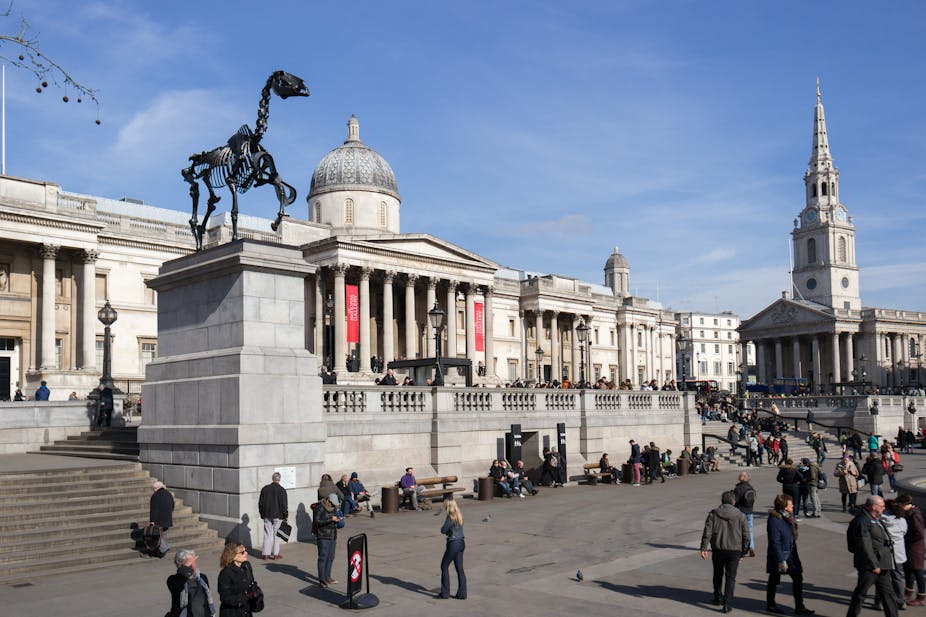As the election race heats up, a cadaverous warning about austerity and stock market sharp practice is casting a disturbing, skeletal grin in the general direction of Whitehall and Downing Street. It’s Hans Haacke’s exquisitely cast bronze Gift Horse, the tenth incumbent of Trafalgar Square’s fourth plinth.
A double life-size skeleton of a horse, it grimly eyeballs (well, eyesockets) the Square’s foot traffic and Nelson on his column. A large bow adorns its daintily extended offside leg-bone and on the bow is a display of electronic data streaming “live” from the London Stock Exchange.
In 2016 David Shrigley’s Really Good, a faintly obscene ten metre-high bronze model of a “thumbs-up” gesture and another distinctly ironic exercise, takes over. Till then, Gift Horse, a first-rate piece of Haacke provocation, will haunt the plinth.
Art for austerity
Gift Horse’s political tendency is unambiguous. Haacke, now aged 78, has framed much of his work in opposition to capitalism and corporate power. He’s made it pretty clear that, on one level at least, Gift Horse symbolises a social body ravaged by free market speculation and the Coalition’s public spending cuts.
Boris Johnson, the work’s official commissioner, knows this perfectly well, as his opening ceremony speech showed. The mayor nailed Haacke’s “emaciated quadruped” as an allegory of George Osborne’s “excessive pursuit of austerity”, but then tried to re-spin it as a representation of a “fantastic” Tory-revitalised London underground system.
The repulsive flippancy of this disavowal of austerity’s effects hasn’t received much comment, so let’s underline Johnson’s self-exposure here and now, as an unanticipated early return from Gift Horse.

Haacke’s politics are clear, but the language his project speaks is twisty. The artist’s reputation rests significantly on early works that were also concerned with capital. Unlike Gift Horse, though, they tended to analyse the relationship between financial and symbolic capital in precise, tightly researched detail.
Taking care of business
In one 1971 work, he used a mass of specific data to expose two decades of dodgy dealing by a powerful New York slum landlord. In doing so he precipitated the cancellation of his own planned solo show at the Guggenheim, since various Guggenheim trustees feared they’d be similarly exposed.
In subsequent projects in the 1970s and 1980s, Haacke revealed the Nazi involvements of the owner of a Manet still-life; business links between the state-owned company British Leyland, the art-collecting advertisers Charles and Maurice Saatchi and apartheid South Africa; and the use of art sponsorship by diverse international corporations as simultaneous PR lubrication and tax dodge.
By contrast, Gift Horse’s use of the London stock market’s ticker display seems a bit imprecise at first glance: a quick fix to the problem of welding the work’s imagery of disease to a symbol of capitalist free-marketeering.
Initially one wonders if it’s necessary, not least because if you mentally strip away Gift Horse’s ribbon, the sculpture’s true pedigree is revealed. By reducing the form of a grand equestrian statue to a skeleton, Haacke isn’t merely playing with an image, he’s creating a stealthy version of a particular and very effective later 20th-century art genre, the “negative-form monument”.
Highlighting gaps
A classic example of this is Horst Hoheisel’s 1987 Aschrott Fountain, in Kassel, Germany. The structure exactly reproduces a fountain that was donated to Kassel in 1908 by a Jewish resident and then destroyed by the Nazis. However, it’s almost invisible: it exists underneath the pavement, its deep voids filled with water.
A more recent example of this principled approach to the building of monuments is Jonas Dahlberg’s design for Norway’s July 22 memorial to the victims of the Utoya massacre. This is a three and a half-metre excavation that slices clean through the tip of Sorbraten peninsula.

The genre’s aim is to negate the language of phony remembrance spoken by so many traditional civic sculptures. By substituting voids for solids and absences for presences, the negative-form monument warns about people’s capacity to ignore, overlook, dismiss or forget (Boris Johnson, take note).
Haacke himself has form in this area: in 1993, when invited to exhibit in the Venice Biennale’s German Pavilion, he famously responded by tearing up the floor and reproducing the facade’s eroded trace of the Nazi-tainted label “Germania” in big bold letters above the rubble.
So, if Haacke’s skeleton horse is a “negative” monument that points up the obsolescence of the “positive” statuary around it, where does that leave its information-streaming, frivolous-seeming bow? Maybe it’s there because its ticker stream, representing a tiny proportion of actual London Stock Market trading, is itself a near-obsolete artifact.
In the modern marketplace, as Michael Lewis’s 2014 book Flash Boys revealed, computers make money by exploiting nanosecond advantages over other computers. There’s nothing “live” about the stream of illuminated data that lights Gift Horse up at night. The bow is a decorative trimming in more than one sense: its data is as dead as the carcass it prettifies.

